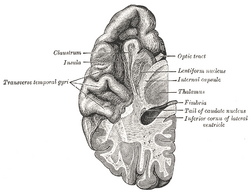Assessment |
Biopsychology |
Comparative |
Cognitive |
Developmental |
Language |
Individual differences |
Personality |
Philosophy |
Social |
Methods |
Statistics |
Clinical |
Educational |
Industrial |
Professional items |
World psychology |
Biological: Behavioural genetics · Evolutionary psychology · Neuroanatomy · Neurochemistry · Neuroendocrinology · Neuroscience · Psychoneuroimmunology · Physiological Psychology · Psychopharmacology (Index, Outline)
| Brain: Transverse temporal gyrus | ||
|---|---|---|
| Section of brain showing upper surface of temporal lobe. ("Transverse temporal gyri" visible at center left.) | ||
| [[Image:|250px|center|]] | ||
| Latin | ' | |
| Gray's | subject #189 824 | |
| Part of | ||
| Components | ||
| Artery | ||
| Vein | ||
| BrainInfo/UW | ancil-655 | |
| MeSH | [1] | |
The transverse temporal gyri (also called Heschl's gyri) are found in the area of primary auditory cortex in the superior temporal gyrus of the human brain. It processes auditory information.
References[]
| This page uses Creative Commons Licensed content from Wikipedia (view authors). |
